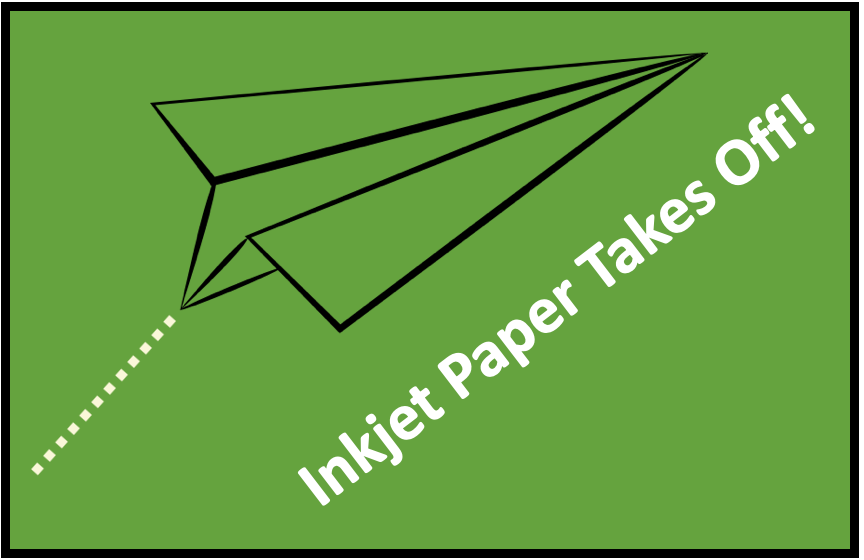As the grand finale to an exciting Inkjet Innovation Week, I had the pleasure of hosting Bill Rojack, vice president of Midland Paper, to discuss “Innovation Foundations: Inkjet Paper and Specialty Media.” An analysis of the trends in the inkjet industry would not be complete without exploring advances in media that can save printers money or open new markets.
According to Rojack, books, magazines and catalogs have been slower to adopt inkjet than other transactional and direct mail markets. However, in 2018, when the inkjet industry lost access to thin papers from Appleton, printers had to scramble to find alternatives. This jumpstarted the paper innovation that has been integral to the expansion of the inkjet print market.
So, what makes paper such an important part of the inkjet process? As I discussed in depth during our first webinar, “Driving Innovation in Web-Fed Inkjet Systems,” it takes a lot of water to print and only fractions of a second for paper to soak that water up. Heat is applied to dry the paper and, if you don’t have the right paper, you can end up with a product that is dry, brittle and subject to curl and cockle. The “right’ paper depends on the application, printer and ink.
Thin Paper
Creating thin papers for book printing is one of the most challenging papermaking segments because mills must control the fiber content, deliver exacting standards on caliper, PPI and smoothness and avoid any natural tendencies to curl while ensuring that any coatings applied don’t impact caliper.
“Coated thin book papers or highly calendered papers made to feel like they’re coated, are well suited for these applications,” Rojack said, “as the fibers are more sealed and compressed, which aids in slowing the migration of the ink into the paper. Keeping that ink from diving in too quickly, provides cleaner images and text clarity.”
A new product from Evergreen Packaging, TruSpec Inkjet Book, addresses these issues. Evergreen has created the only truly coated inkjet-grade paper that uses the HP ColorPRO technology. This product features a matte coating, wide color gamut, can handle high ink densities, has excellent dimensional stability and meets SIMRA textbook standards. This leads to exceptional image quality and faster print speeds, while using less ink. It’s not yet commercially available, but it is coming soon.
Crown Van Gelder provides a thinner paper offered at 41 to 47lb which is their LetsGo-Thin High Opaque Paper. Their focus for this highly calendared treated paper are book and pharmaceutical markets. CVG has also found an eco-friendly and economical alternative for titanium dioxide. This additive absorbs and attracts reflected light, giving it minimal show through with high print definition.
Calendered Paper
So what is this calendered paper exactly?
“It’s a great innovation, but it’s been the cause for some confusion in the market,” Rojack said. “Calendering is the smoothing process where the paper is pressed between calender rolls or stacks. The more calendering you do, the smoother it becomes. These hard pressure rollers, that we call calenders, are at the very end of the paper machine. The calenders and the technique used is what determines the smoothness and fiber compression helping lower the porosity of the paper.”
In turn, by making the paper less porous, mills can slow down the absorption rate of the inks, resulting in a higher-quality product. So highly calendered paper does not necessarily have an exterior coating, though it looks much like coated paper.
It’s an offset treated paper that provides a larger color gamut, because it keeps more of the color on the surface. If someone says they have a coated paper, clarify how that paper is going to perform in your process. Although it looks coated, it’s still going to respond differently than a coated paper would.
Crown Van Gelder just released their 3rd generation of their LetsGo family of papers. They have modified its surface for a smoother coated look and feel, resulting in superior processing characteristics. CVG also has in-house resources that they are now sharing with their customers to help with color management.
Innovations
Color management support is just one of many ways paper suppliers are making themselves more available and valuable to their customers. Navigator Premium Inkjet is now offering splice-free products for their paper line of products. The fiber used, eucalyptus globulus, has a higher number of fibers per weight unit, resulting in optimal ink retention and drying, better optical densities and higher color contrast.
So what other markets can benefit from paper innovations?
Folded self-mailers are a great market for inkjet, but the cost of the add-ons for producing self mailers can be limiting and costly. However, there is a way to make moving into self-mailers easier. Pre-finished rolls can be directly printed on an inkjet press safely without finishing costs.
InfoSeal is a converter that can process rolls and sheets for pre-finished stock, ready for inkjet printing. Printers can now provide pre-perfed, pre-glued Snap Pak self mailers, pressure seal, poly windows, integrated cards, dynamic die cuts and pre-moist glue for business reply envelopes. This is cost-efficient and can be streamlined into current print production.
To get the detailed discussion on paper innovation, watch the full “Innovation Foundations: Inkjet Paper and Specialty Media” webinar and check out the rest of the innovation week webinars at www.inkjetinsight.com.

